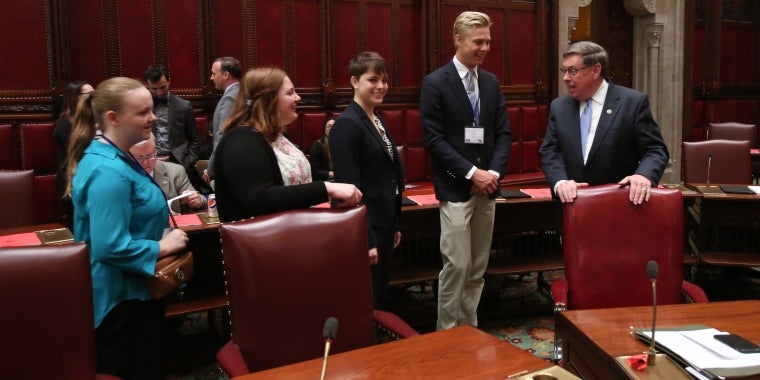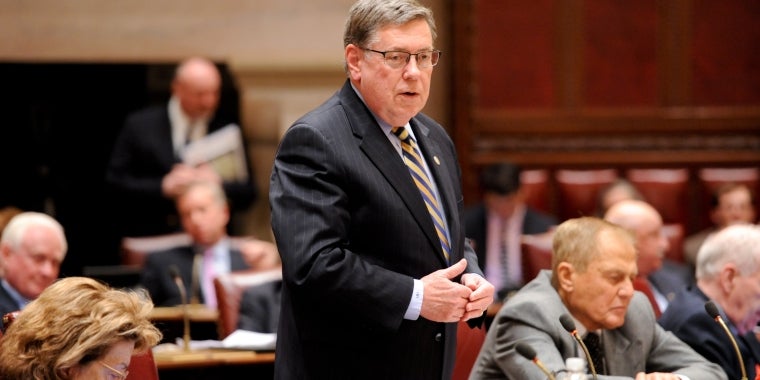
Senate Passes Upstate Now
The New York State Senate today passed Upstate Now, a comprehensive job creation and economic growth plan that will transform and revitalize the upstate economy, generate billions of dollars in new investment, and create thousands of new jobs for New Yorkers.
The 10-point plan (S.5953A) would invest a total of more than $3.7 billion into economic development initiatives over the next three years, including new tax relief and incentives, new and existing capital investments and private sector matching funds. More than $2 billion would be invested in the first year of the program.
"The Governor has talked about the need to address the Upstate economy, but his budget did not deliver what he promised to help create jobs," Senate Majority Leader Joseph L. Bruno said. "In fact, his $1.7 billion in proposed tax and fee increases would hurt businesses and taxpayers across the State. The Senate’s Upstate Now plan addresses the core issues facing small and large businesses in every sector of the economy by providing tax relief, investments and other measures to help business prosper, grow and create new jobs.
"Had we enacted Upstate Now a year ago when the Senate first advanced it, we would be announcing new businesses and jobs right now," Senator Bruno said. "We need action, not more rhetoric. This is a comprehensive plan that has strong support from business leaders across the state."
The Senate's comprehensive plan would: reduce taxes, energy and health care costs for employers; provide upstate with a 21st century economic infrastructure; strengthen small businesses, manufacturing, agriculture, tourism and other key industries throughout the State; make upstate an international leader in new and emerging technologies; revitalize downtowns and local communities throughout the region; support clean, renewable energy initiatives; strengthen our workforce; and enact sweeping reforms to make the upstate region more business-friendly and economically competitive.
"Upstate Now includes many plans that have worked so successfully to make the Capital Region a global leader in high tech economic development, including infrastructure improvements, business incentives and encourage partnerships among the public and private sectors and our outstanding colleges and universities," Senator Bruno said. "We have a successful model, a blueprint that can be applied for the rest of Upstate.
"We need action immediately, with the Senate’s Upstate Now plan and prudent capital investments, we can turn the economy around in Upstate and across all of New York," Senator Bruno said. "Last July, the Senate, Governor and Assembly announced an agreement on several issues, including a plan for $1 billion in capital investments to create jobs.
"The Senate pushed hard for the capital investments," Senator Bruno said. "However, the Governor did not hold up his end of the agreement. Instead, the Governor has gone around the State announcing the same capital monies and making that same $1 billion a focal point of his State of the State message. If the agreement from July had gone forward, we could have been making real capital investments to create jobs."
"The Upstate Now initiative, which the Senate has passed two years in a row, provides precisely the type of comprehensive action we need to make New York more competitive economically with other states and countries," said Senator Alesi, Chairman of the Senate Committee on Commerce, Economic Development and Small Business. "Lowering taxes, providing affordable healthier plans for small businesses, investing in new technology and reducing energy costs will not only attract new businesses to our region, but allow businesses currently in Upstate to retain their employees and pay them good wages. This plan taps into the vast potential our region has so we can secure a brighter, more prosperous future for our families. The hardworking citizens of Upstate New York should not have to wait another day for aggressive action to create jobs and strengthen the Upstate economy. We can not afford to wait any longer on this issue. I urge the Assembly and Governor to join the Senate in taking action now."
The Senate’s Upstate Now plan includes more than $2.6 billion in tax cuts and incentives, when fully implemented in three years; as well as $300 million in existing venture capital funds that will generate an additional $300 million in private sector matching funds; $300 million in capital monies originally proposed in the Executive Budget, but not included in the adopted budget; $155 million in new capital investment funds; and $58 million in new economic development program investments.
From tax cuts, to the JOBS NOW and Pipeline for Jobs initiatives, to the Jobs 2000 Plan (J2K), Gen*NY*sis, and Centers of Excellence programs, the Senate Majority has always been the principal driving force in Albany behind efforts to promote economic growth and job creation for New Yorkers. The Upstate Now package would build on this legacy with a broad, comprehensive and integrated 10-point plan:
1. Reducing Taxes for Small Businesses, Manufacturers and Key Industries
2. Building and Investing in a 21st Century Infrastructure for the Upstate Economy
3. Making Upstate an International Powerhouse in New and Emerging Technologies
4. Reducing Energy Costs for Employers and Promote Energy Independence
5. Reducing Health Care Costs for Small Businesses to Insure More Families
6. Creating Thriving Main Streets
7. Winning the Global Competition for Manufacturing Plants
8. Preparing the Finest Workforce in the Nation
9. Providing Around the Clock Access to the State's Economic Development Programs
10. Marketing Upstate's Outstanding Recreational, Cultural and Tourism Opportunities
Business Council President Kenneth Adams said, "All New Yorkers interested in a more prosperous Empire State should welcome the Senate's unwavering support for this broad effort to reinvigorate New York's economy, especially Upstate. The ideas advanced by Senator Bruno and the majority conference include broad business-tax reductions, steps to reduce employers' costs of energy and health insurance, and proposals for strategic high-tech investments that can help renew New York's economy. The Upstate Now package is clearly a great addition to the policy debate in Albany. We hope the Assembly can support these proposals, and we look forward to the policy ideas it will add to this discussion."
James R. Sherin, President and CEO of the Retail Council of New York State, said: "The Senate’s aggressive and forward-looking package addresses the urgent needs of every sector of the upstate economy. A better tax environment for businesses and for homeowners means better conditions for retailers small and large, with new stores opening on Main Street and more job opportunities across the board."
The UPSTATE NOW Economic Development Plan (Specific Components)
1. Reducing Taxes for Small Businesses, Manufacturers and Key Industries:
Taxes play a key role in helping companies decide where to locate, invest and create new jobs. From eliminating income and corporate franchise taxes on upstate’s manufacturers, to further reducing corporate tax rates, to enacting much needed property tax relief for small businesses, the Senate’s plan will help fuel economic growth in upstate for years to come. The Senate will also pursue efforts to simplify New York’s complex tax code and to reform the Wick’s Law.
John Richardson, Director of Public Affairs for Eastman Kodak Company, said: "Many of the State’s challenges can be traced to an uncompetitive business environment. Incentives to drive increased investment in Upstate New York are critical. The Upstate Now package is significant as it is a broad-based business incentive package. Further, it emphasizes new investment utilizing previously earned investment tax credits. This package will drive investment and jobs for the Upstate area."
Mike Elmendorf, State Director of the National Federation of Independent Business, New York's leading small business advocacy organization, said: "I commend the Senate and Majority Leader Bruno for their leadership in not only recognizing that the core problem stifling small business is the high cost of doing business in our state, but for taking action to correct it. Upstate Now takes direct aim at that issue by, among other things, cutting taxes and taking steps to reduce healthier and energy costs on small business. Allowing small businesses to keep and reinvest more of what they work so hard to earn is the best economic development and job creation policy."
Specific elements of the plan's first component include:
Ÿ
Eliminating Business Taxes on Manufacturing in New York State (This would provide $60 million in tax relief, growing to nearly $500 million in relief when fully implemented).
Ÿ
Providing property tax rebates for small businesses that employ fewer than 20 employees. (Under the Senate's plan, a new Small Business STAR program would be established. It would deliver direct rebate checks, averaging $700, to small businesses that pay school taxes and employ less than 20 people. This measure would provide $150 million in property tax relief).
Ÿ
Reducing the Corporate Franchise Tax Rate from 7.1 percent to 6.85 percent (This would provide $35 million in tax relief, growing to $94 million when fully implemented).
Ÿ
Reduce other taxes on small businesses, aviation and marine fuel.
Ÿ
Encouraging the Federal Government to stop taxing New York’s economic development incentives (Currently, federal law requires New York employers to pay federal taxes on the capital and equipment investments that the State makes to lure major employers like Advanced Micro Devices (AMD) and IBM. This places New York at a tremendous disadvantage with foreign competitors when it comes to attracting major new investments in manufacturing and/or technology facilities).
Ÿ
Capitalize on unused investment tax credits to provide investment in upstate.
2. Building and Investing in a 21st Century Infrastructure for the Upstate Economy:
Upstate Now calls for hundreds of millions of dollars in targeted investments in upstate’s infrastructure. Projects include establishing high-speed trains in key upstate corridors, expanding our roads, water lines and technology infrastructure to support job growth. The plan would also create commerce and economic growth zones around regional airports to promote location of new businesses."Improving our roads and bridges is key to our economic success -- from Binghamton to Buffalo to the North County to Long Island," said Senator Tom Libous (R-I-C, Binghamton), Chair of the Transportation Committee. "And enhancing air and rail service is also vital to creating a better climate for business growth to generate new jobs."
Specific elements of the plan's second component include:
Ÿ
$300 million in capital to support key economic development and emerging technology projects.
Ÿ
Building high-speed passenger trains to interconnect New York's cities.
Ÿ
Rebuilding roads and bridges with a Highway and Bridge Capital Plan.
Ÿ
Supporting the infrastructure to provide broadband access across the State.
Ÿ
Reviving our water and sewer line infrastructure to support growth.
Ÿ
Investing in the 21st Century Food Laboratory in Geneva and the State Data Center in Utica.
Ÿ
Creating new commerce and economic growth zones around regional airports.
3. Making Upstate an International Powerhouse in New and Emerging Technologies:
The Senate is advancing new incentives to encourage emerging technology companies that already do research and development in New York, to take that next step and actually manufacture their products in the Empire State. The plan would also seek to more fully integrate the groundbreaking research taking place at New York's outstanding colleges and universities, with the local and regional private-sector economies across upstate.The plan makes extensive investments to support expansion and assist in the retention of agribusiness and agriculturally related jobs in the State
. Building upon the success of the J2K Program, $100 million in critical capital funding will be distributed through regional partnerships enacted in 2006.
Senator Michael Nozzolio said: "Through our investments in high-tech industrial development and utilization of the resources provided by our world-class universities, such as Cornell and the University of Rochester, we are positioning New York to become a leader in the economy of the 21st century. The aggressive agenda outlined today will create more good-paying jobs and revitalize New York's economy."
Specific elements of the plan's third component include:
Ÿ
Attracting major manufacturers with refundable tax credits, such as those that were successfully utilized to secure the AMD investment in the Capital Region.
Ÿ
$100 million for regional partnerships for strategic investments.
Ÿ
Taking advantage of the existing $300 million for regional venture funds to spur new investment and job creation.
Ÿ
Investing in Agribusiness and Agricultural Enterprise Applied Research and Technology.
Ÿ
Promoting and encouraging research produced in New York.
Ÿ
Authorizing a sales tax exemption for businesses in academic incubators.
Ÿ
Providing commercialization assistance grants.
Ÿ
Increasing the Qualified Emerging Technology Company Credit.
Ÿ
Creating Incentives for Bioscience and Nanoscience commercialization.
Ÿ
Supporting new capital investments in Upstate's Outstanding Emerging Technology Centers.
Ÿ
Reconfiguring Economic Development zones to address rural needs.
"Technological breakthroughs and opportunities in agriculture and agribusiness can become the powerhouse to revive the upstate economy," Senator Cathy Young (R-C-I, Olean) said. "Farming continues to be the pillar of New York's rural communities, generating hundreds of thousands of jobs both on and off farms. Investment in New York agriculture is multiplied through its impact on the many businesses in our rural communities that support the farm industry."
New York Farm Bureau President John Lincoln said: "The Senate’s continued commitment to Upstate economic development will greatly benefit our family farmers who are the backbone of the rural economy. New York Farm Bureau truly believes the key to revitalizing the Upstate economy is through agriculture, its largest industry. We greatly appreciate the Senate’s dedication to making sure New York’s family farmers thrive."
4. Reducing Energy Costs for Employers and Promote Energy Independence:
New York’s small business leaders have consistently cited high energy costs as a major obstacle to future growth, profitability and new job creation. To address this problem, Upstate Now advances a tax credit program that would help eligible small businesses afford the rising cost of energy. In addition the upstate plan will ensure that New York will have renewable energy for the future. Encouraging renewable energy products to sustain future economic growth without being held hostage to a petroleum based economy.Specific components of the energy package include the following:
Ÿ
Promoting energy independence and clean alternative energy.
Ÿ
Providing Energy Cost Assistance to Small Businesses (This initiative would provide a $350 million refundable energy tax credit to help 386,000 small businesses).
Ÿ
Providing Solar and Fuel Cell Manufacturer Tax Credits.
Ÿ
Offering Cellulosic Ethanol Production Tax Credit.
Ÿ
Offering Alternative Energy Use Tax Credit.
Ÿ
Eliminating the Petroleum Business Tax on Nonresidential Heating Fuel.
Ÿ
Providing $300 million for investments in clean, renewable energy research and commercialization, including clean coal and bio-fuels.
Ÿ
Reducing property taxes for land used for Biofeedstock Production.



